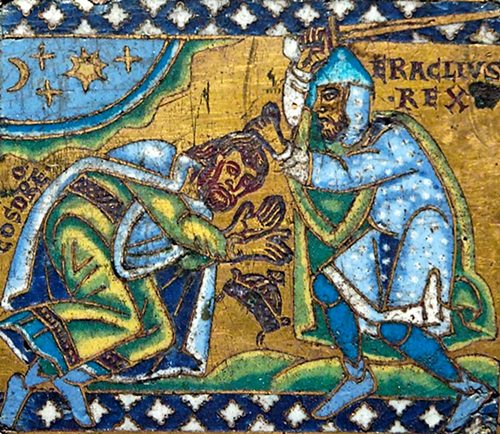
Battle of Nineveh(Battle of Zab) |
year: 62712 December 627 |
| A decisive victory by Heraclius which ended the war with Persia | ★ ★ ★ ★ ★ |
|
enemy: Sassanid Persians
|
location: In a plain west of the Great Zab river, at some distance from the ruins of ancient Nineveh. The location is in modern north Iraq, near the city of Mosul
|
accuracy:
●●●●●
|
|
battle type: Pitched Battle |
war: Byzantine-Persian Wars |
modern country:
Iraq |
| ▼ The Byzantines(emperor: Heraclius) | ▼ The Enemies | |
| Commander: | Emperor Heraclius | General Rhahzadh |
| Forces: | 25,000 to 50,000 | 12,000 |
| Losses: | 6,000 |
| Background story: |
| As the war that had begun in 602 between Sassanid Empire and the Byzantine Empire came close to its 26th year, Heraclius made a bold and totally unpredictable move: As the campaigning season of 627 ended, he gathered his heterogeneous army of Turks (40,000 Gokturks allies) and Romans and invaded the Persian heartland at the beginning of September. The news threw Shah Khosrau into a panic. After 15 years of war his army was exhausted and his 2 foremost generals were not available. Shahin was dead and Shahrbaraz was away in Egypt, fearing that Khosrau wanted him dead. So Khosrau gathered an army and appointed as its commander Rhahzadh (or “Razatis”), a warlike and brave nobleman. Rhahzadh moved to cut off Heraclius and prevent him from reaching Ctesiphon, the Persian capital. Heraclius continued burning and pillaging as he went, Rhahzadh following Heraclius, bidding his time until he was ready to meet the Romans. The Göktürks, however, quickly deserted him because of the strange winter conditions. On 1 December, Heraclius crossed the Great Zab River and camped near Nineveh. This was a movement from south to north, contrary to the expectation of a southward advance. However, this can be seen as a way to avoid being trapped by the Persian army in case of a defeat. Rhahzadh approached Nineveh from a different position. News that 3,000 Persian reinforcements were approaching reached Heraclius, forcing him to act. On 12 December 627, Heraclius drew up his army on the plain and waited for Rhahzadh. |
The Battle: |
 Chosroes submits to Heraklios (Louvre) With Rhahzadh's death perished the Persians' hopes of victory: seeing their brave commander and many other high-ranking officers being slain by Heraclius and his troops, the Persians lost heart and were slaughtered. |
Noteworthy: |
| Under the peace treaty, the Byzantines regained all their lost territories. Heraclius took also back the True Cross which was carried back by the released Byzantine prisoners of war. Heraclius himself brought the Cross into Jerusalem on foot. |
Aftermath: |
| The Persian army rebelled and overthrew Khosrau II, raising his son Kavadh II (Siroes), on the throne. Siroes sued for peace. Heraclius did not impose harsh terms neither advanced to Ctesiphon, as both armies were exhausted. The war ended and this was one the greatest victories in the history of Byzantium. The Persians were down but their fall gave room to a new threat: the Arabs. |
|
|
